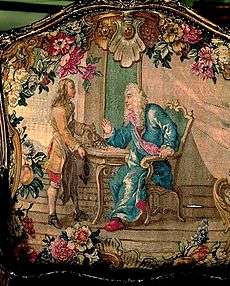The Cobbler and the Financier

The Cobbler and the Financier (Le Savetier et le Financier) is one of La Fontaine's Fables that deals directly with a human situation rather than mediating it through the behaviour of animal stereotypes. An adaptation from a Classical Latin source, it gained some currency in England during the 18th century.
A fable of dependency
La Fontaine's account is based on a story told by Horace in his verse epistle to Maecenas (I.7)[1] concerning the lawyer Philippus and the crier Volteius Mena. The lawyer amuses himself by befriending a carefree and contented man and destroys his peace of mind by presenting him with the means to buy a farm. It is a disaster and eventually his client begs Philippus to return him to his former way of life. In the poem, Horace is pointing out to Maecenas that the obligations of his client status should not be urged to the point of damaging his health and that, if he cannot be allowed his independence, he is ready to return the benefits he has received in the past. The story he tells follows immediately after a shorter reference to one of Aesop's animal fables pointing to the same conclusion, "The Fox and the Weasel".
La Fontaine adapts the story to the circumstances of his own century.[2] A Financier's troubled rest is broken by the merry singing of a cobbler. The man of affairs interviews the workman about his business and offers him a gift of a hundred crowns to guard against a rainy day. Worry over the security of his nest-egg destroys the cobbler's own rest and allows the financier a period of unbroken repose. Finally the cobbler brings back the money and demands the return of his songs and his sleep. This particular passage is based, not on the story but on Horace's suggestion to Maecenas in the poem that he should give him back his health and light-hearted laughter (lines 25-8). The poem is also marked by many memorable lines, including the financier's wish that sleep was a commodity to be bought at market and the cobbler's suspicion that his roaming cat is after his money.
A fable that follows La Fontaine's account fairly closely was included soon after in Roger L'Estrange's Fables of Aesop and Other Eminent Mythologists (1692)[3] and a verse translation of La Fontaine appeared later in Charles Denis' Select Fables (1754).[4] However, Jonathan Swift had already made a humorous adaptation of Horace's poem at the start of the 18th century, retelling the story of his ruinous patronage by the Earl of Oxford in a more direct manner than had Horace, and in the process drawing out the original forty lines of the Latin author to 140 in octosyllabic couplets.[5]
Interpretations
The majority of French illustrations to this popular story picture the dramatic moment when the cobbler strides into the financier's presence to return the bag of coins. Marc Chagall, however, prefers to represent him singing at his work in the coloured etching of 1952.[6]
The 18th-century composer Henri-Joseph Rigel made a two-act comic opera of the fable in 1778. He was followed by Jacques Offenbach who, having set the fable for soloist and small orchestra as part of his 6 fables de la Fontaine in 1842,[7] later adapted the story to a one-act comic opera in 1856 in which the heroine sings a parody of his own setting. In that light-hearted entertainment, the cobbler turns the tables on his opponent by using the 300 crowns he is given to beat the financier at cards, taking over all his assets and winning the hand of his daughter.[8] The fable was also set for children's choir and orchestra by Ida Gotkovsky as part of her Hommage à Jean de La Fontaine in 1995.
Two early silent films were also based on the fable: Le Savetier et le Financier of 1909, made by La Société des Etablissements L. Gaumont[9] and another with the same title made in 1912 by La Société Française des Films Éclairs.[10]
References
- ↑ Horace: Satires, Epistles, Ars Poetica, Loeb edition, London 1942, lines 45-95
- ↑ Fable VIII.2
- ↑ Fable 402 p.372
- ↑ Fable 112, “The Cobler and his Neighbour”, pp.415-8
- ↑ "To the Earl of Oxford" (1713)
- ↑ Goldmark Gallery
- ↑ There is a performance on YouTube
- ↑ There is a 45-minute performance of the work on YouTube
- ↑ IMDb
- ↑ IMDb